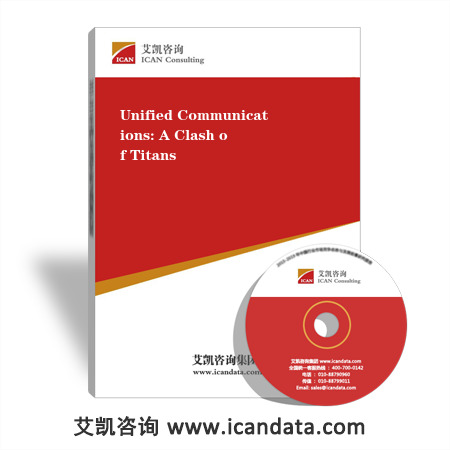导读:统一通信,分析分析,Unified Communications,A Clash of Titans Abstract Unified communications (UC) promises a transformation of the business landscape by facilitating closer collaboration among employees, suppliers, and customers. But the revolution al
数据来源与研究方法:
- 对行业内相关的专家、厂商、渠道商、业务(销售)人员及客户进行访谈,获取最新的一手市场资料;
- 艾凯咨询集团对长期监测采集的数据资料;
- 行业协会、国家统计局、海关总署、国家发改委、工商总局等政府部门和官方机构的数据与资料;
- 行业公开信息;
- 行业企业及上、下游企业的季报、年报和其它公开信息;
- 各类中英文期刊数据库、图书馆、科研院所、高等院校的文献资料;
- 行业资深专家公开发表的观点;
- 对行业的重要数据指标进行连续性对比,反映行业发展趋势;
- 通过专家咨询、小组讨论、桌面研究等方法对核心数据和观点进行反复论证。
报告简介:

Abstract
Unified communications (UC) promises a transformation of the business landscape by facilitating closer collaboration among employees, suppliers, and customers. But the revolution also creates seismic industry shifts, as titans like Microsoft, IBM, and Cisco, position themselves for larger shares of the growing unified communications pie.
This report contains an analysis of the current state of UC from both industry and end user perspectives. Vendor strategies and survey results of business decision makers’ current and planned adoption of UC applications are presented. Also included is an updated analysis of market shares of the US and worldwide unified messaging (UM) and traditional voice messaging markets, along with forecasts for each by geographic region through 2012. Forecasts for unified communications products and services across the same time period are also included in the report.
The report demonstrates that UM, a key component of UC, is leading the way with the demise of traditional voice mail on the horizon. Further, the integration of conferencing into the UC framework clearly represents a near term opportunity bring real-time functions into the UC framework and encourage users to change long ingrained communications habits.
Contents
- Executive Summary
- Who is Defining Unified Communications?
- Unified Communications Supplier Strategies
- Messaging Market Share Analysis
- Nortel’s Losses Are Cisco’s Gain in the Unified Messaging Market
- Traditional Voice Mail Approaching End of Life
- Messaging and Unified Communications Market Forecasts
- Traditional Voice Mail Forecast
- Unified Messaging Forecast
- Unified Communications Forecast
- Methodology
- Glossary
- List of Tables
- Table 1. Supplier Statements Regarding Unified Communications
- Table 2. Currently Used/Planned Next 12 Months Feature Breakdown, by Business Size
- Table 3. Current and Planned Use of Web Access to Both Email and Voice Mail
- Table 4. Current and Planned Use of Email Fax
- Table 5. Current and Planned Use of File Sharing and Collaboration
- Table 6. Current and Planned Use of Remote Access to Call Forwarding
- Table 7. Current and Planned Use of Web Conferencing
- Table 8. Current and Planned Use of Audio Conferencing
- Table 9. Current and Planned Use of Desktop Video Conferencing
- Table 10. Current and Planned Use of Click to Call From Email
- Table 11. Current and Planned Use of PC-Based Softphone
- Table 12. Current and Planned Use of Instant Messaging Integrated With Conferencing
- Table 13. Current and Planned Use of Text to Voice Conversion of Email Into Voice Mail
- Table 14. Current and Planned Use of a Dashboard to Manage Communications
- Table 15. Current and Planned Use of Room-Based Video Conferencing
- Table 16. Current and Planned Use of Presence Management
- Table 17. Current and Planned Use of Access to PBX Features From a Mobile Phone
- Table 18. Responses to Planned/Used Based on Hardware vs. Software vs. Services
- Table 19. Respondent Preferences for Various Types of Unified Communications Providers
- Table 20. Importance of Potential Unified Communications Applications
- Table 21. Responses to Statements Regarding Unified Communications Strategy
- Table 22. Responses to Question Regarding Factors Hindering/Slowing Implementation of UC
- Table 23. Responses to Question Regarding the Impact of Economic Slowdown on Deployment Plans
- Table 24. 2007 Worldwide Messaging Market End User Revenues (US$ in Millions) and Shares
- Table 25. Worldwide Unified Communications Clients and Revenues Broken Down, by Region
- Table 26. 2007 UM/UM-Capable Clients and Revenue Market Share, US and Worldwide
- Table 27. 2007 Ports and Revenue Market Share for Traditional Voice Mail, US and Worldwide
- Table 28. Worldwide Traditional Voice Mail Port Shipments and Revenues, 2007-2012
- Table 29. US Traditional Voice Mail Port Shipments and Revenues, 2007-2012
- Table 30. Worldwide and Regional Unified Messaging Forecast by Clients and Revenues, 2007-2012
- Table 31. Revenue Forecast for Products Sold As Part of a UC Solution, 2007-2012
- Table 32. Revenue Forecast for Services Sold As Part of a UC Solution, 2007-2012
- List of Figures
- Figure 1. Worldwide Unified Communications Product/Services Revenue, 2007-2012 (US$ in Millions)
- Figure 2. Siemens Openscape Unified Communications Vision
- Figure 3. Current and Planned Use of Fifteen Unified Communications Features
- Figure 4. Industry Players Coming at Unified Communications from Multiple Directions
- Figure 5. The Many Facets of Microsoft’s Relationship with Alcatel-Lucent
- Figure 6. Microsoft’s Vision of the Team Room of the Future
- Figure 7. Polycom CX100, CX200, and CX700 Phones for OCS2007
- Figure 8. IBM Lotus Sametime Web Conferencing Screen Shot
- Figure 9. Cisco Unified IP Phone Presence Changes From Available to “In A Call” in OCS2007
- Figure 10. 2007 Worldwide UM/UM-Capable Market Share Based on End-User Revenues
- Figure 11. 2007 US UM/UM-Capable Market Share Based on End-User Revenues
- Figure 12. 2007 Worldwide Market Share for Traditional Voice Mail Based on End-User Revenues
- Figure 13. 2007 US Market Share for Traditional Voice Mail Based on End-User Revenues
统一通信分析分析
















